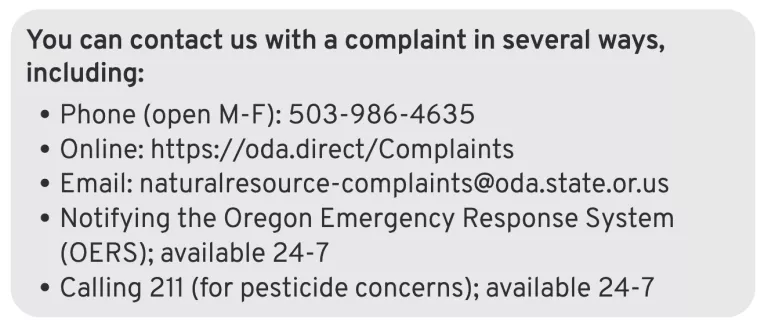
R6, State & Private Forestry, Forest Health Protection, Public via Wikimedia Commons
Not a lot has changed with respect to the use of pesticides over the past decade, and the news isn’t good. The term “pesticide” includes any chemical used to control “pests” like insects, rodents, and weeds. An “herbicide” is a type of pesticide that targets weeds and other unwanted plants. The Oregon Department of Agriculture and other agencies broadly use the word pesticide, so that is the term used in this article. Many of the pesticides currently in use were originally developed as chemical warfare agents. For example, Agent Orange, used in the Vietnam War as a defoliant, was originally tested in forests along the Oregon Coast (learn more by reading Carol VanStrum’s book Bitter Fog and watching the movie The People Versus Agent Orange). 2,4D, a component of Agent Orange, is still broadly used today.
Now, many of these products can be applied legally, because they’re registered with the Environmental Protection Agency (EPA). In Oregon, pesticides are used to reduce competition for Douglas fir “working forests”, mitigate invasive plant species, and control weeds in agriculture. The product descriptions are frightening and often contradictory (for example, sulfometuron methyl has a “high potential for reaching surface water via runoff for several months or more after application” but, it should be applied “as a preemergence or early postemergence spray during the rainy season…”). Pesticides are usually sprayed as a mixture of different active compounds (e.g., atrazine, 2,4-D, glyphosate, chlorpyrolid, triclopyr, hexazinone) as well as inert ingredients (e.g., defoamers, sticking agents, surfactants, solvents).
For example, there are currently plans to apply twelve different pesticides on over 1,630 acres in the Siuslaw National Forest annually in an effort to control invasive plant species as a restoration effort. “Proposed activities may occur in all management areas including Wilderness, Wild and Scenic River corridors, Research Natural Areas and National Recreation Areas.” The proposed action plan states, “Fluazifop targets grasses which makes it a valuable tool in treating butterfly habitat.” This is ironic, because Mallick et al. (2023) found that pesticides adversely affect butterfly species – specifically fluzifop-pbutyl, along with sethoxydim, glyphosate, and imazapyr, which are all on the plan’s pesticides list.
Once an invasive species becomes established, it is rarely possible to eradicate it. For example, Himalayan blackberry seeds are spread by birds, which is why they are commonly found under perching sites, such as along fence rows and under power lines. Many people pick blackberries to eat and make preserves out of them. If they’re sprayed with pesticides, these individuals will be poisoned. This warning is posted on solvepestproblems.oregonstate.edu:

If swaths of land are sprayed with pesticides via backpack sprayers and drones, other edible food sources (e.g., salmon berries, mushrooms) can also become contaminated. In the past year (September 2023-2024), 381 aerial spray operations were completed in Oregon, which translates to ~610,000 acres.
Pesticide Application is Imprecise
Even when pesticides are sprayed in limited areas, they can spread broadly by drift, re-volatilization, and by getting into nearby streams and waterways – especially after it rains. Re-volatilization occurs as the morning sun warms the earth, and with moisture in the air, the fog lifts with a mixture of the pesticides sprayed earlier and can travel for miles. Pesticide sprays can have devastating consequences on both the local wildlife and the surrounding environment. A recent study detected pesticides (e.g., hexazinone and atrazine) used in forestry management practices in 38% of bivalve samples along the Oregon Coast. Pesticides used in forestry practices have also been linked to behavioral abnormalities in salmon (e.g., swimming performance, seaward migration, adult returns), compromised immune systems, and endocrine disruption.
We don’t yet know how these products interact with each other in synergistic, cumulative, and/or additive ways. Evidence of toxicity is dependent on dose, so at low levels, people may develop autoimmune disease or a low sperm count; at higher levels, they may experience headaches, sore throats, rashes, dizziness, cancer, or death. The State of Oregon Pesticide Management Plan for Water Quality Protection states “Prevention of water contamination is a major component of effective resource management.” Many of the pesticides proposed for use in the control of invasive weeds are listed in the plan’s appendix B listing “Oregon Pesticides of Interest: potential to occur at concentrations approaching or exceeding a Federal, State, or Tribal human health or environmental reference point.” It is very challenging to monitor water quality, yet based on the research cited above, it is clear that pesticides HAVE contaminated our forests and water systems.
The Oregon Department of Forestry’s Forest Activity Electronic Reporting and Notification System (FERNS) requires timber operators to share information about where, what, and how they will be applying pesticides; however, when applications might actually occur can span months. No specific notification date is required for residents who live near ground sprays, but sometimes an operator will notify residents as a courtesy, if requested. Through FERNS, you can sign-up to be notified of logging, spraying, road building, and other operations in an area that you designate on Oregon Department of Forestry’s interactive map.
It is incredibly challenging to monitor drinking water supplied from forest ecosystems for pesticides contamination because 1) it is challenging to get information about which pesticides, from the list provided, were actually applied, and 2) when they were applied. In contrast to pesticides used in agriculture, forest applications are sporadic and hard to monitor, which, according to the Department of Environmental Quality (DEQ), is why the state agencies responsible for monitoring water quality can’t include groups like the Seal Rock Water District in the Pesticide Stewardship Partnerships Program. Five compounds used in a Beaver Creek watershed spray application in the fall of 2023 (sulfometuron-methyl, DEET, atrazine, glyphosate, Imazapyr) were found in drinking water as reported by the DEQ after a one-time study in 2014. In this report, the pesticides diuron and linuron were consistently over EPA limits for drinking water in sites sampled. Watch Piercing the False Narrative: Logging and spraying in Oregon’s drinking watershed for a great overview of pesticides in drinking water.
The Answer? Money
So how can the EPA approve the use of these pesticides when its mission is “to protect human health and the environment”? And why is the US Forest Service keen to apply pesticides so broadly across our national forests when its mission is “to sustain the health, diversity, and productivity of the Nation’s forests and grasslands to meet the needs of present and future generations”? And why can’t the DEQ do more to monitor drinking water quality when its mission is “to be a leader in restoring, maintaining and enhancing the quality of Oregon’s air, land and water”? Excellent questions. Answer: money. In a nutshell, the companies that manufacture these pesticides want to ensure that their products will continue to be broadly sold. A 2008 report from the Oregon Department of Agriculture concluded that 3,098,503 pounds of pesticides were applied in the southern Oregon coastal region in one year, and glyphosate followed by 2,4-D were the most commonly applied pesticides. Lobbyists work on behalf of these companies to ensure that their products have a secure market. The American Legislative Exchange Council (ALEC) “is America’s largest nonpartisan, voluntary membership organization of state legislators dedicated to the principles of limited government, free markets and federalism.” Through this organization, lobbyists for companies like Bayer (manufacturer of glyphosate or “Roundup”) and Corteva Agriscience (a spin-off of Dow AgroSciences that manufactures 2,4-D as Enlist Duo) worked with politicians to create and pass Right to Farm statutes in all 50 states. Key points include:
- 30.933. Legislative findings; policy… (2) The Legislative Assembly declares that it is the policy of this state that: … (c ) Persons who locate on or near an area zoned for farm or forest use must accept the conditions commonly associated with living in that particular setting.
- 30.939. Pesticide uses considered farming or forest practice … (2) Notwithstanding ORS 30.930 (4), the use of a pesticide shall be considered to be a forest practice for purposes of ORS 30.930 to 30.947, if the use of the pesticide: … (c ) Complies with applicable laws; (d) Is done in a reasonable and prudent manner; and (e) Includes, but is not limited to, site preparation, timber harvest, slash disposal, road construction and maintenance, tree planting, precommercial thinning, release, fertilization, animal damage control and insect and disease control.
- 30.943. Investigation of complaints based on farming or forest practice The Department of Environmental Quality, Department of State Lands, State Department of Agriculture or State Forestry Department is not required to investigate complaints if the agency has reason to believe that the complaint is based on practices protected by ORS 30.930 or 30.947.
Politicians often influence federal agency bureaucracies: "EPA Scientists Said They Were Pressured to Downplay Harms From Chemicals. A Watchdog Found They Were Retaliated Against." Even when the EPA tries to ban a compound, like chlorpyrifos, manufacturers appeal decisions so that they can continue their sales: “Court tosses EPA ban on pesticide linked to brain damage in kids”. And the DEQ is woefully underfunded and unable to routinely analyze samples of drinking water that depend on forest watershed systems. Recently, it came to light that the US Agency for International Development and US Department of Agriculture helped fund private social networks that attack pesticide critics around the world – it’s a global problem.
Pesticide Exposure
If you’re concerned about having been exposed to pesticides, reach out to Oregon’s Pesticide Analytical and Response Center (PARC). They advise to immediately 1) get help, 2) leave the area, 3) wash off the pesticide, 4) write key information, and 5) report it. There are ways to report pesticides concerns, starting with the Oregon Department of Agriculture. If you want to submit a complaint or file an alleged loss, go online and download the right form. Many pesticides concerns are time sensitive, so don’t delay! Collectively, perhaps our voices will eventually make a difference.

From the Oregon Dept. of Ag website
The Oregon Chapter Forest Team wants to hear from you! Please share your experience with pesticide / herbicide spraying in Oregon by filling out this short survey.
To join the work of the Forest Team and address harmful chemical spraying in our forests, please contact Carol via email at cvalentinemusic@gmail.com.